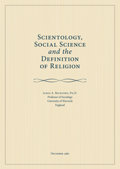It is clear to me that Professor Parrinder, Professor Pocock and Canon Drury have each suggested criteria by which a phenomenon might qualify as religious in a substantive sense. By this I mean that various grounds are provided by them for restricting the application of the term “religion” to phenomena displaying definite properties which do not occur together in other phenomena.
The strongest form of substantive definitions holds that religion has an essence or essential nature which can be known for certain only by intuition and introspection. Thus, Rudolf Otto claimed that religion was a “…primal element of our psychical nature that needs to be grasped purely in its uniqueness and cannot itself be explained from anything else”. (The Idea of the Holy. Harmondsworth: Penguin Books, 1950, p. 141.) In his opinion the uniqueness of religious experiences lay in their radical differences from all other experiences: they were the experiences of the “wholly other”. The elements of circularity and timelessness in this kind of reasoning are problematic and have deterred most social scientists from making use of essentialist definitions. The attractions are, however, undeniable.
More frequently social scientists have been disposed to use “stipulative” definitions of religion. By this means they have stipulated that, for their purposes and without claiming universal validity for their views, “religion” shall be identified by reference to certain characteristics. For the anthropologist M. Spiro, e.g., religion is “an institution consisting of culturally patterned interaction with culturally postulated superhuman beings.” (“Religion: problems of definition and explanation” in M. Banton ed. Anthropological Approaches to the Study of Religion. London: Tavistock, 1966, p. 96.) Not all social scientists insist, however, on the reference to “superhuman beings”. P. Worsley, another anthropologist, finds it more useful to define religion as a “dimension beyond the empirical‑technical realm”. (The Trumpet Shall Sound. London: MacGibbon & Kee, 1957, p. 311.) This preference for a substantive, but fairly inclusive, definition is shared by many sociologists. The well‑known and authoritative definition by R. Robertson, e.g., stipulates that,
Religious culture is that set of beliefs and symbols…pertaining to a distinction between an empirical and a super‑empirical, transcendent reality: the affairs of the empirical being subordinated in significance to the non‑empirical. Second, we define religious action simply as: action shaped by an acknowledgement of the empirical/super‑empirical distinction. (The Sociological Interpretation of Religion. Oxford: Blackwell, 1970, p. 47.)
No good purpose would be served by adding further examples of stipulative substantive definitions, since the quoted examples are representative of the common ways in which religion is defined for the purpose of social scientific analysis.
[T]here can be no doubt that Scientology qualifies for the purposes of social scientific analysis as a religion. Its underlying philosophy of man assumes that the person is composed of both a material body and a non-material spirit which enjoys immortal life in a non-empirical realm.
Using the definitional criteria implicit in Spiro’s, Worsley’s and Robertson’s definitions, there can be no doubt that Scientology qualifies for the purposes of social scientific analysis as a religion. Its underlying philosophy of man assumes that the person is composed of both a material body and a non‑material spirit which enjoys immortal life in a non‑empirical realm. Belief in the reality of thetans is a logical prerequisite for subscription to Scientology’s rituals, courses of practical training, counselling services and programmes of social reform. There would be no cogent justification for Scientology’s particular forms of religion in the absence of belief in the existence and the superiority of a non‑empirical, transcendent reality. Indeed, in the view of the author of the most authoritative sociological analysis of Scientology the movement’s founder and leader became progressively more oriented towards questions about the origins of the thetan, knowledge of past lives and “the supernatural abilities that the individual can acquire through the practice of Scientology”. (R. Wallis, The Road to Total Freedom. London: Heinemann, 1976, p. 124.)
The actions of a committed Scientologist would be shaped and guided by the empirical/super‑empirical distinction. Professor Parrinder has demonstrated effectively how the rituals of Scientology embody an element of worship and veneration which is consonant with the underlying teachings about non‑empirical reality and Professor Pocock has emphasised the clear parallels between Scientology and the Great Traditions of the Hindu and Buddhist religions in respect of their similar understanding of the immanent relationship between Gods or spirits and mankind.





























